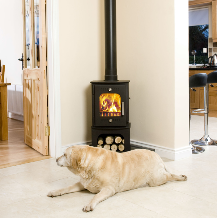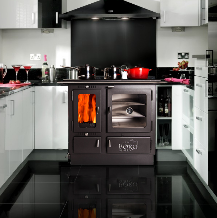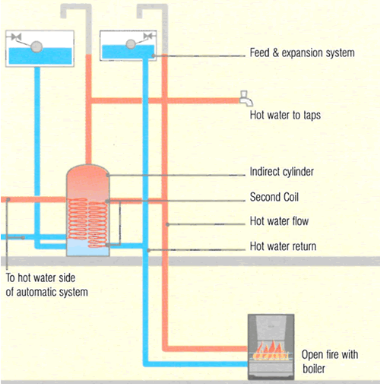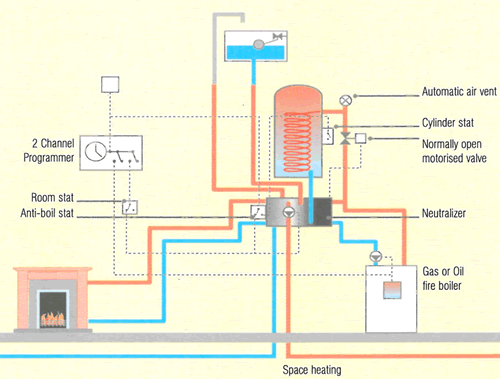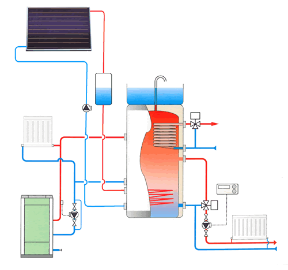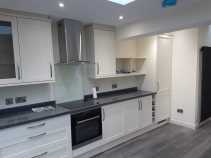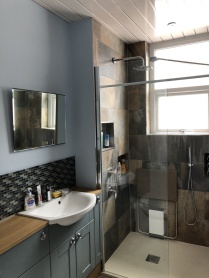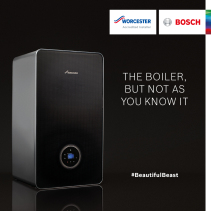Heating Design - Solid Fuel Systems
Everyone loves the look of a real fire and now integrated or linked-up systems allow you to utilise a solid fuel boiler alongside other heating technologies such as gas, oil, heat pumps or solar to provide maximum flexibility.
Flexible heating
The real advantage of linking up oil or gas systems with a solid fuel one is its flexibility. You can enjoy the cosy comfort of a solid fuel fire or stove and at the same time derive a wider heating contribution from it. When the fire is not lit the primary central heating operates as normal.
A good hearth makes a fireplace great !!
Interlinking appliances can be achieved in a number of different ways and the method chosen will depend on the existing system and the output of the appliances being linked.
Whichever method is chosen, it is essential to ensure that the solid fuel appliance has an unrestricted open vent and separate cold feed - it’s very difficult to link up with a combi boiler or other sealed system boiler!!
The main ways to link up the heating systems are;
- Simple Link
- Simple Indirect Link (Via Coil)
- Full Link
- Thermal Store Link
Simple Link-up
(Hot Water Only)
In its simplest form, an open fire, room heater or stove fitted with a back-boiler can be linked to an existing or new central heating system.
- The existing or primary boiler continues to service the system as and when required.
- The hot water and radiators can be supplied by either or both appliances depending on the heat required.
- Link-up can apply to either hot water only or both hot water and radiators.
- Solar panels can be integrated to maximise efficiency by providing ‘free’ hot water from the sun when it is available.
Link-up can be very simple and inexpensive if only a limited additional benefit is required. In many cases a simple link-up is most cost effective when an open fire or stove is added to an existing central heating system. By using a boiler flue-set with domestic hot water back-boiler or a boiler stove, it is possible to improve the efficiency of a fireplace and generate additional hot water.
Where a glass lined or similarly rust-proofed boiler is fitted to an open fire or stove, the boiler can be connected directly to the domestic hot water cylinder. This type of system was originally used years ago for the production of hot water from open fires but is still valid today.
Simple indirect Link-up
(Hot Water Only)
In this instance, a standard boiler is used and the water in the cylinder is heated indirectly via a coil. It requires the fitting of an additional cold feed and expansion tank to service the new system and allows the use of a standard boiler. In the strictest sense of the word, this is not a link-up as the two appliances have a separate system and heat the same cylinder via separate coils
In a house fitted with solar panels, the heat generated can be used to indirectly supply a twin coil hot water cylinder. In this way, hot water can be obtained all year round using the power of the sun backed up by your solid fuel boiler during the cooler months.
Full Link-Up
(Hot Water & Central Heating)
A fully linked up or integrated system enables more than one appliance to contribute to the central heating system as well as the domestic hot water.
In the past there have been problems associated with linking two dissimilar heating appliances into the same heating system, There are now specialised products on the market which enable link-up via a Neutral Point Vessel or Neutraliser / Centraliser.
Benefits of a neutral point vessel
Because both appliances are only connected through the vessel which has a comparatively large volume, pumped and gravity circuits are hydraulically de-coupled so will not affect each other.
In other words, the pumped circuit from a gas or oil boiler will not induce or hinder the flow through a solid fuel boiler via its gravity circuit. A system incorporating a neutralising vessel can connect several different appliances together without them interfering with each other hydraulically.
Thermal Store Link-Up
(Hot Water & Central Heating)
The thermal store system takes the principle of the neutralising vessel one step further by providing considerable heat storage as well as neutralisation of water circulation.
A thermal store is a large tank (typically 200-300 litres) very much like a hot water cylinder but instead of containing domestic hot water it’s filled with primary or system water. Both the appliances and heating circuits are connected directly rather than via a coil.
Direct connection means that the store holds primary water. In other words it is the same water that is circulating around the stove or the gas boiler. The thermal store acts as the neutral point of the system and also stores some or all of the heat produced for later use.
Domestic hot water can be supplied at mains pressure via a secondary coil inside the store or through a separate plate heat exchanger. This means that many different sources of heat can be integrated into the same system.


